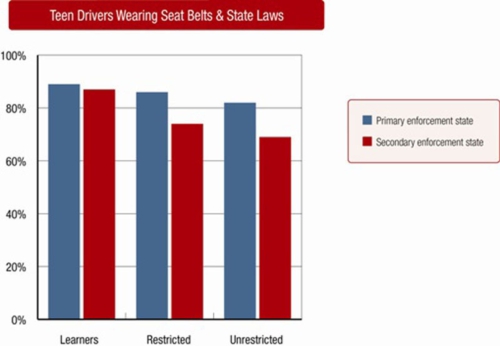While most teens do buckle up when driving, new research shows that novice teen drivers who live in states with so-called “secondary enforcement” seat belt laws are less likely to use the life-saving devices than those in “primary enforcement” states. The research, conducted by The Children’s Hospital of Philadelphia (CHOP) and State Farm®, is published in the American Journal of Public Health. The research found seat belt use rates differed as teens moved through the probationary licensing process known as Graduated Driver Licensing (GDL).
A primary seat belt law allows an officer to stop a vehicle and issue a citation simply for not wearing a seat belt. A secondary seat belt law only allows for a citation to be issued if the vehicle is stopped for a primary violation, such as speeding.
For the study, researchers examined a nationally-representative sample of 3,126 high school students who described themselves as drivers and found that 82 percent reported regularly wearing seat belts as drivers and 69 percent as passengers. Teens who live in states with primary seat belt laws were 12 percent more likely to buckle up as drivers and 15 percent more likely to buckle up as passengers compared to teens who reside in states with weaker secondary enforcement laws.
The research also showed the long-term effectiveness of strong seat belt laws. As teen drivers advance through GDL, from the supervised “learner’s permit” to “probationary license” to “unrestricted license”, they are more likely to continue to wear their seat belts in states with primary seat belt laws as compared to states with secondary enforcement laws.
“Teens in the learner’s permit phase of licensure reported similar belt use, regardless of whether their state had a primary or secondary law,” noted Felipe J. Garcia-Espana, Ph.D., co-author of the study and a researcher at CHOP’s Center for Injury Research and Prevention, “but driver seat belt use declined to 69 percent in secondary-law states as teens advanced to an unrestricted license, while seat belt use remained relatively steady at 82 percent in states with primary laws.”
The researchers observed particularly low seat belt use among specific groups of teens, including those living in rural areas, African-Americans, students with low grades or attending schools in lower socioeconomic districts, and those driving pickup trucks. Seat belt use among these groups was higher in states with primary enforcement laws, showing that the laws help narrow safety disparity gaps.
“Teen crashes are complex events with multiple factors contributing to them. However, the main reason teens die in these crashes is failure to buckle up,” explained Dennis Durbin, MD, MSCE, co-scientific director of the Center for Injury Research and Prevention and co-author of the study. “This study suggests that if state laws don’t reinforce the importance of seat belt use, teens may be less motivated to buckle up and are placed at much higher risk of being injured or killed in a crash.” Using a seat belt reduces the risk of a fatal injury by 45 percent, according to the National Highway Traffic Safety Administration.
Until all states have a strong primary enforcement belt law, researchers say the burden falls on parents to enforce the buckle up message, as well as on teen drivers to insist their friends use seat belts on every trip.
“Parents play an important role in making sure their kids always wear a seat belt, whether or not their state has a strong seat belt law,” said Dr. Durbin. “They should start by setting the example of always wearing a seat belt as a passenger and as a driver, and remind their teen that they and their passengers need to be wearing seat belts on every trip− no matter how short− in order to keep their driving privileges.”
“Among all of the safety messages bombarding teens today, this may be the easiest to act on: Buckle up on every ride. This simple act can make the difference between life and death,” said Chris Mullen, director of Technology Research, Strategic Resources at State Farm Insurance.
For complete information about this research and other teen driver safety resources, visit www.teendriversource.org or http://teendriving.statefarm.com.

Search TeenAuto
Socialize with Us
Like us on FacebookFollow us on TwitterWatch our Channel